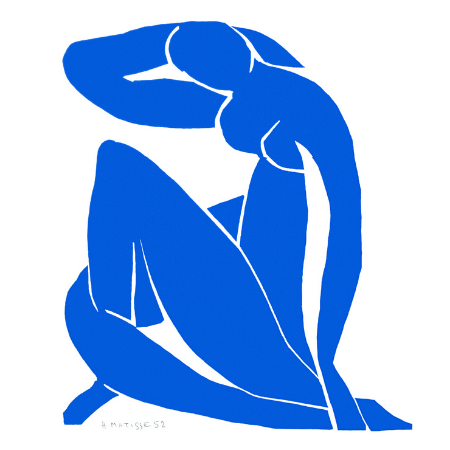Art & Culture
Henri Matisse JAZZ and Theater

Blue Nude Ⅱ, 2007, work by Henri Matisse ©Succession H.Matisse

My Art Museum presents the solo exhibition of Henry Matisse (1869-1954) as the first in Korea, celebrating the 150th anniversary of the artist’s birth in 2020.
Matisse, a French Fauve, is widely recognized as one of the finest artists of the 20th century along with Picasso.
The prolific artist produced vast range of works from oil paintings to drawings, sculptures, prints, cut-outs and book illustrations during 50 years of his artistic life.
This exhibition introduces more than 120 various works by Matisse including his representative series, produced in “cut-outs” during his later life, drawings and lithographs together with his original costumes designed for ballets and the Rosary Chapel.
In particular, intense colors of and its expression of nature in pattern, which were inspired by the artist’s travels to Tahiti and Morocco, show how pure and passionate Matisse was toward art in his late years.
The exhibition consists of works from the collections of the Picasso Museum in Germany, the Lambert Collection in Avignon, the Ballet de Monte-Carlo of Monaco and the Collection Marzocco.
The simple and implicit forms of Matisse’s cut-outs had extensive influence over the 20th-21st century’s abstract art and minimalism design. By providing an opportunity to enjoy the beauty of vivid colors and delicate lines alive in different media throughout the oeuvre of Henry Matisse, this special exhibition will bring emotional comfort and experience of happiness to the depressed hearts of the people in this time of COVID-19.
Advertisement
French artist Henri Matisse (1869 -1954) making paper cutouts in bed athis home in Vence, France, circa 1947. Photo by Hélène Adant /Archive Photos via GettyImages
In the history of art, Henry Matisse is one of the most important-color painters during the modern period, but all the artistic processes Matisse took are rooted in the strong but elegant lines shown in the nude drawings in particular. Odalisque refers to court lady in Turkish palace or woman of harem, which was one of the major themes for Orientalism in the early 19th century, often seen in the works of many painters, including Ingres, Delacroix and Renoir’s.
Since the early 1920’s, when Matisse was staying in southern France, he showed continuous interest for exotic odalisque paintings. He reproduced alluring images of woman out the ladies of harem he met in Morocco or models in oriental clothes. The artist depicted his models in seductive ways and by placing them in front of decorative background, he created the effect of conveying strange but intense forms and colors.
By the year of 1941, Matisse starts to produce paper ‘cut-outs’ on his bed or armchair as he found it hard to stay seated in front of easel with age.
Among his cut-out works, the series, produced in 1947 with the theme of circus, is considered to capture the peak of Matisse’s gouaches découpés. For, Matisse first worked on the writings and then added more than 20 illustrations to the texts.
Although the book has circus and play as its subject, it was titled ‘jazz’ because of the variability of the content in it.
Arabesque work by Henri Matisse ©Succession H.Matisse
First, Matisse painted with Gaush and cut the paper then attached with pins on the wall. These finished works were stenciled and published as the print book. In the 1947 edition of the book, the arrangements of cut-outs reflect the original display they had on the interior walls of the artist’s residence. Matisse says he could reach higher level of perfection through cut-out during the last 10 years of his life, than he did with paintings or sculptures. Cut-outs provided a solution to his long-standing question of “the eternal conflict of drawing and color.”
Circus (Le Cirque) 1947 work by Henri Matisse ©Succession H.Matisse
In 1919, Matisse was asked by the director of a Russian ballet company to design costumes and stage art for the premiere of 'The Song of the Nightingale.' The plot of the ballet is based on Andersen’s fairy tale that tells a story of a mechanical nightingale, a gift from the Emperor of Japan to the Chinese emperor. In reproducing the court of the Emperor, Matisse used oriental ornaments to decorate costumes for the dancers.
The artist added his original details to historical designs and this resulted in creating costumes that seem surprisingly contemporary even now. Through the design for ‘The Song of the Nightingale,’ Matisse could extend
his artistic experiment to stage. He worked on the costumes based on his childhood memories about fabrics in Boen to design patterns, and this also served as an opportunity to try on cut-out technique.
©LES BALLETS DE MONTE-CARLO
©LES BALLETS DE MONTE-CARLO
Between 1941 and 1944, Matisse dedicated huge amount of time and energy to work on illustrations for poetry books of the representative French Romantic and Surrealist poets such as Aragon, Mallarmé and Baudelaire.
In 1932, Matisse unveiled 29 etchings as illustrations for Mallarmé‘s. The illustrations show an exquisite harmony between Matisse’s soft but clear and implicit lines and the literary purity in the poems of Mallarmé. After this work, Matisse also produced illustrations for many collections of poems including Baudelaire’s (1947) and Ronsard's (1948).
While the illustrations of Matisse relate to poems, they also have independent value as formative art. Since drawings are expressed in concise lines rather than being descriptive of the poems, viewers are required to think and imagine further. This is the reason why Matisse-illustrated copies of French Romantic poetry books are still acknowledged also as stand-alone art works and collected.
work by Henri Matisse ©Succession H.Matisse
Find us
© Copyright 2020 ECCK · All Rights Reserved








